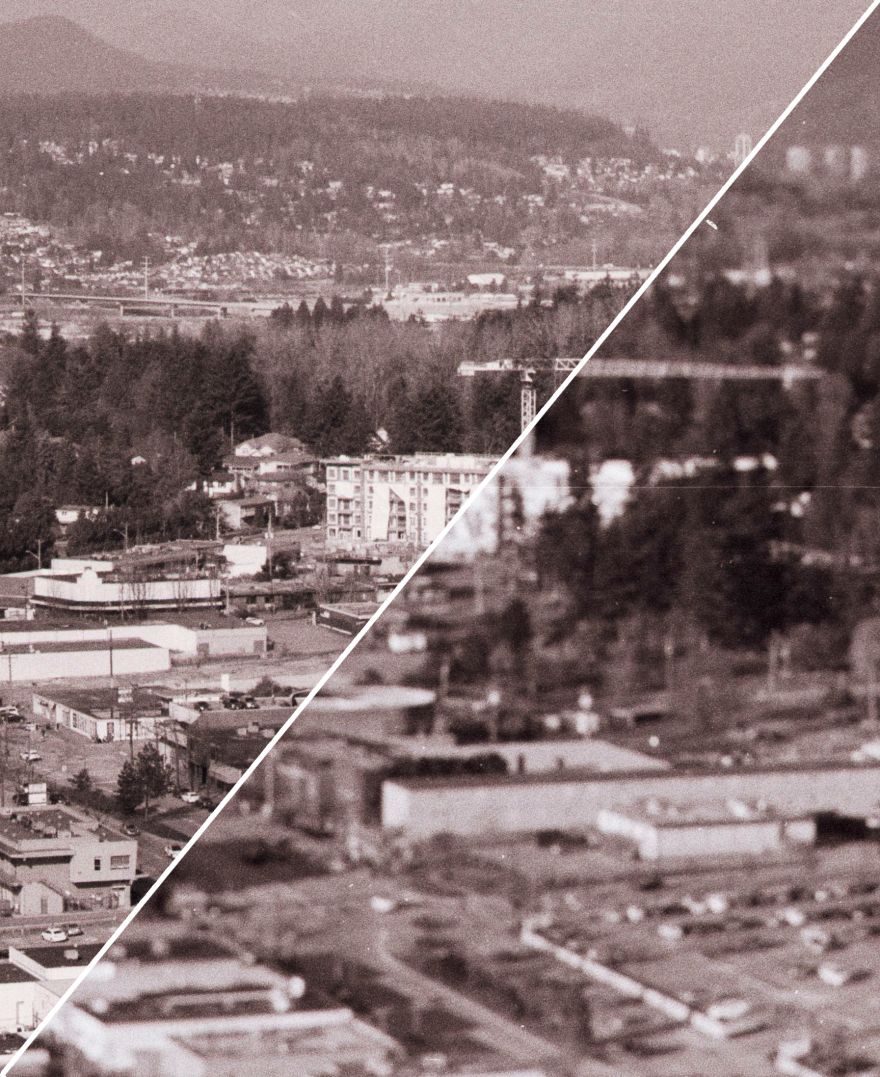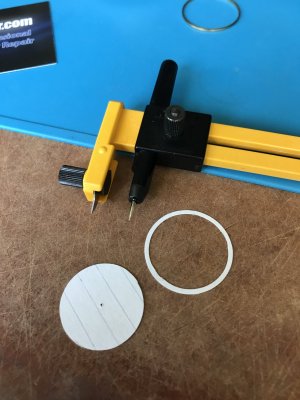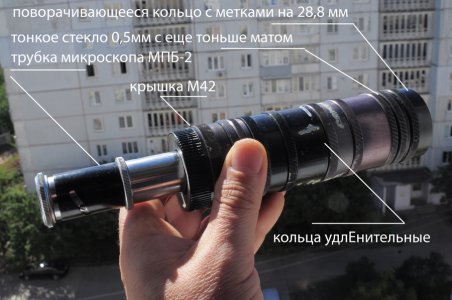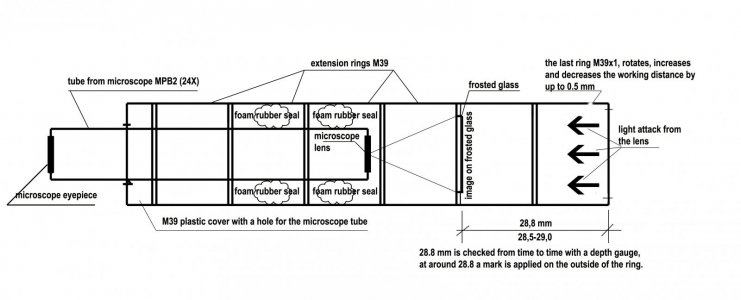Go for it! Nikon made this in F-Mount, I have one. They made it for their "Mirror-up" lenses ~1960.How about this one from China

Imageable Lens Cap for E-mount / Leica M-mount High Camera Back Cover | eBay
Find many great new & used options and get the best deals for Imageable Lens Cap for E-mount / Leica M-mount High Camera Back Cover at the best online prices at eBay! Free shipping for many products!www.ebay.com
What I would do: attach a magnifying loop to the back to use for precision focus. That is essentially what my TTL view does.
TO ADD... For $10, I bought the M-Mount version. I will use my Magnifying Loop and then check against my Leica M9. The M9- I use as the "Gold Standard" when adjusting lenses, has been used to set many lenses for other people.
Brambling
Well-known
Brambling
Well-known
Brambling
Well-known
During the manufacture, it suffered - the plastic cover M39, everything else is suitable for disassembly and use for its intended purpose.
jc031699
Member
I couldn’t find one of those, will look at the focus caps.I found this one years ago looking for Camera Repair Tools. They are called "Field Previewers". This one was made by Canon.
I decided to try this route:

How to Calibrate Infinity Focus on a Rangefinder
This guide will show you how to calibrate infinity focus on your film rangefinder camera without having to go to a repair shop or buying expensive tools.
The circular cutter I mentioned previously works great for making novel shims for my Nikon 5cm f2 LTM too!

jc031699
Member
Definitely would love to know what you find with this setup. I just ordered a couple from AliExpress too, to assess sample variation.Go for it! Nikon made this in F-Mount, I have one. They made it for their "Mirror-up" lenses ~1960.
What I would do: attach a magnifying loop to the back to use for precision focus. That is essentially what my TTL view does.
TO ADD... For $10, I bought the M-Mount version. I will use my Magnifying Loop and then check against my Leica M9. The M9- I use as the "Gold Standard" when adjusting lenses, has been used to set many lenses for other people.
The method I use fir first cut at adjusting the Shim: focus using a Canon III with 1.5x finder on a Lamp at a known distance, 5m. Then use my TTL viewer to test against the distance scale of the lens. Change the shim until the distance scale aligns, which by now I do by just eyeballing it. BUT- the formula for focal length can be used to find the error in back focus. 1/f= 1/d+ 1/b. Use F=52.4.
jc031699
Member
This worked great for me, so far. The USB microscope works great for viewing the focusing screen, with its light turned off using the dial on the cord.I decided to try this route:
Using a Pentax focusing screen and a usb microscope from Amazon. Will see how that goes. Also bought one of those $5 focusing targets to facilitate setup on a bench top (kitchen island).
How to Calibrate Infinity Focus on a Rangefinder
This guide will show you how to calibrate infinity focus on your film rangefinder camera without having to go to a repair shop or buying expensive tools.www.analog.cafe
I was able to shim for near focus at 1 meter for my two Jupiter-8 lenses. The silver KMC, I also had to adjust the focal length to reach infinity, which ended up being 0.4mm of shortening (limited by the length of the threads on the rear element fixture). The black KMC, I think I only have to shim, seems to reach infinity OK.
Also gave me an opportunity to check wide-open near focus on other lenses:
1) Nikon 50mm F2 LTM, needed shims (0.43mm)
2) Canon 50mm F1.4 LTM, needs a lot of shims (0.54mm and counting), still waiting on getting some in the mail
3) Summaron 35 F3.5 LTM, spot on with the M2 that it came on
4) CV Color Skopar 28mm F3.5 LTM, not quite there on near focus, did not shim (off by ~0.18mm based on a shim trialed between lens and LTM-LM adapter)
5) CV Color Skopar 21mm F4 M-mount, not quite there on near focus, did not shim
I would like some advice on the two CV wide angle lenses: These are practically brand new, bought used. I am making a basic assumption that they were calibrated well at the factory and I am seeing the 1% error which will be acceptable, given I am using these for film, due to the large circle of confusion for <35mm focal lengths. Is this correct? Or am I seeing a rangefinder calibration problem on the M2?
I am waiting on the shims for the Canon, to run a roll of film and check near and infinity focus.
Also, why are the Nikon and Canon so far off? They still had their native shims inside, not missing like in my silver Jupiter-8. Is it reasonable to assume that someone has messed around with switching shims or fixtures to other lenses at some point?
Last edited:
jc031699
Member
Ah, I see now that this means that someone must have re-assembled the helicoids incorrectly. Time for some mechanical sleuthing, I suppose.
 rangefinderforum.com
rangefinderforum.com
Update: I checked, and the distance rings are not that far off on the 50mm lenses. The distance scales are perfect on my CV and Summaron lenses. Back to shimming, I suppose.
Canon LTM - Canon 28mm 2.8 LTM focusing issue
Hi! I have an issue with a recently purchased Canon 28mm 2.8 LTM lens. Trying the lens (but not yet tested with a film) on both my M2 (CLA’ed) and my IIIf with comparisons with my other lenses (Summaron 35mm 2.8 and Summitar 50 2) show discrepancies on the distance indication ring. I mean...
 rangefinderforum.com
rangefinderforum.com
Update: I checked, and the distance rings are not that far off on the 50mm lenses. The distance scales are perfect on my CV and Summaron lenses. Back to shimming, I suppose.
Last edited:
That is way off! I've never seen a Nikkor off that much, they were shimmed for wide-open use. I have the three 5cm F2, 5cm F1.5, and 5cm F1.4: all were perfect on the M9.This worked great for me, so far. The USB microscope works great for viewing the focusing screen, with its light turned off using the dial on the cord.
I was able to shim for near focus at 1 meter for my two Jupiter-8 lenses. The silver KMC, I also had to adjust the focal length to reach infinity, which ended up being 0.4mm of shortening (limited by the length of the threads on the rear element fixture). The black KMC, I think I only have to shim, seems to reach infinity OK.
Also gave me an opportunity to check wide-open near focus on other lenses:
1) Nikon 50mm F2 LTM, needed shims (0.43mm)
2) Canon 50mm F1.4 LTM, needs a lot of shims (0.54mm and counting), still waiting on getting some in the mail
Also, why are the Nikon and Canon so far off? They still had their native shims inside, not missing like in my silver Jupiter-8. Is it reasonable to assume that someone has messed around with switching shims or fixtures to other lenses at some point?
The Canon- three 50/1.4: perfect, 50/1.5: was optimized for F2.8 and I changed it.
jc031699
Member
What do you think happened, wild guesses welcome!That is way off! I've never seen a Nikkor off that much, they were shimmed for wide-open use. I have the three 5cm F2, 5cm F1.5, and 5cm F1.4: all were perfect on the M9.
The Canon- three 50/1.4: perfect, 50/1.5: was optimized for F2.8 and I changed it.
I tested the "Field Previewer" lens cap- not accurate enough to use for focusing. The screen is also too coarse for good focus. Either use as a field previewer only, or pull out the screen that is in it- and accurately shim a Pentax focus screen into the position.
It sounds like someone did a CLA on them and lost some shims, or used it on a camera that was way off. Hard to tell. I've seen Jupiter-3's that were off 3mm. Several off my 0.5mm- which is huge.What do you think happened, wild guesses welcome!
jc031699
Member
Thanks for this. I just got a Jupiter 12, will use the field previewer cap as a rear cap for that. Perfect use!I tested the "Field Previewer" lens cap- not accurate enough to use for focusing. The screen is also too coarse for good focus. Either use as a field previewer only, or pull out the screen that is in it- and accurately shim a Pentax focus screen into the position.
jc031699
Member
I ended up adding 0.9mm to the Canon 50/1.4, weird…That is way off! I've never seen a Nikkor off that much, they were shimmed for wide-open use. I have the three 5cm F2, 5cm F1.5, and 5cm F1.4: all were perfect on the M9.
The Canon- three 50/1.4: perfect, 50/1.5: was optimized for F2.8 and I changed it.
Someone must have disassembled the lens and lost the shim. That amount, around 1mm- is typical of how the lens leaves the factory.I ended up adding 0.9mm to the Canon 50/1.4, weird…
jc031699
Member
Yes really strange though, there was a 1.05mm shim in there already. I had to add 0.9mm. The distance scale is pretty close, when checking against the rangefinder, so I didn't think it likely a helicoid problem.
jc031699
Member
Hi Brian,
Quick question-
In the PDF on reducing J-3 focal length, you describe polishing down the optical unit so that the rear element group can sit closer to the front element group. My understanding is that this allows the longer focal length lenses to focus to infinity following focus calibration by adding shim(s). This is an interative process where the focal length is shortened and then the shim(s) are readjusted for close focus.
When do you use the helicoid mount adjustment (described in the first few posts of this thread) to bring the lens to infinity, vs. using the focal length reduction to bring the lens to infinity? I'm not clear on when each of these processess applies.
Thank you-
Lots of variables going on -
1) The Cam not driving the Rangefinder to Infinity when the lens is at infinity: the helical is not deep enough into the lens mount. I've had about 1 in 10, especially Valdai lenses that will not drive the RF of the camera to infinity. On those: was necessary to polish down the helical. An iterative process, polish a little and then test for infinity. Consider this Step 1, and a painful one.
2) Lens drives RF of camera to infinity- now time to measure the actual focus. Most lenses, this means setting the shim. Test focus close-up and at infinity. Usually focus is acceptable at infinity stopped down to F2.8 or so. Sonnar focus shift at work.
3) Some lenses have a focal length that is too long, and distance focus in unacceptable after shimming the lens. There is a 1% deviation, with ~52.4mm in the middle. So- the long side, focal length is ~53mm. For these lenses- moving the rear triplet closer to the front group lowers the focal length. As you move the rear triplet towards the front group, the main shim needs to be reduced to keep the back of the rear element the correct distance from the image plane. This is a trial and error method, and you will be able to get the focal length closer to the Leica standard- but not exact.
4) Very rare: Two lenses, I had to increase the spacing of the rear group. These lenses were "assembly practice", were never used- looking at the glass.
1) The Cam not driving the Rangefinder to Infinity when the lens is at infinity: the helical is not deep enough into the lens mount. I've had about 1 in 10, especially Valdai lenses that will not drive the RF of the camera to infinity. On those: was necessary to polish down the helical. An iterative process, polish a little and then test for infinity. Consider this Step 1, and a painful one.
2) Lens drives RF of camera to infinity- now time to measure the actual focus. Most lenses, this means setting the shim. Test focus close-up and at infinity. Usually focus is acceptable at infinity stopped down to F2.8 or so. Sonnar focus shift at work.
3) Some lenses have a focal length that is too long, and distance focus in unacceptable after shimming the lens. There is a 1% deviation, with ~52.4mm in the middle. So- the long side, focal length is ~53mm. For these lenses- moving the rear triplet closer to the front group lowers the focal length. As you move the rear triplet towards the front group, the main shim needs to be reduced to keep the back of the rear element the correct distance from the image plane. This is a trial and error method, and you will be able to get the focal length closer to the Leica standard- but not exact.
4) Very rare: Two lenses, I had to increase the spacing of the rear group. These lenses were "assembly practice", were never used- looking at the glass.
jc031699
Member
Ok, got it. So 1) is the lens being able to reach infinity but the rangefinder does not show that the two images coincide. This should be able to be checked without doing a focus check I think.Lots of variables going on -
1) The Cam not driving the Rangefinder to Infinity when the lens is at infinity: the helical is not deep enough into the lens mount. I've had about 1 in 10, especially Valdai lenses that will not drive the RF of the camera to infinity. On those: was necessary to polish down the helical. An iterative process, polish a little and then test for infinity. Consider this Step 1, and a painful one.
2) Lens drives RF of camera to infinity- now time to measure the actual focus. Most lenses, this means setting the shim. Test focus close-up and at infinity. Usually focus is acceptable at infinity stopped down to F2.8 or so. Sonnar focus shift at work.
3) Some lenses have a focal length that is too long, and distance focus in unacceptable after shimming the lens. There is a 1% deviation, with ~52.4mm in the middle. So- the long side, focal length is ~53mm. For these lenses- moving the rear triplet closer to the front group lowers the focal length. As you move the rear triplet towards the front group, the main shim needs to be reduced to keep the back of the rear element the correct distance from the image plane. This is a trial and error method, and you will be able to get the focal length closer to the Leica standard- but not exact.
4) Very rare: Two lenses, I had to increase the spacing of the rear group. These lenses were "assembly practice", were never used- looking at the glass.
2) is the near focus calibration to fit the Leica flange to focal plane distance.
and 3) is another infinity focus check after doing 2), with 2) and 3) being iterative / cyclical. Right?
Share:
-
This site uses cookies to help personalise content, tailor your experience and to keep you logged in if you register.
By continuing to use this site, you are consenting to our use of cookies.





